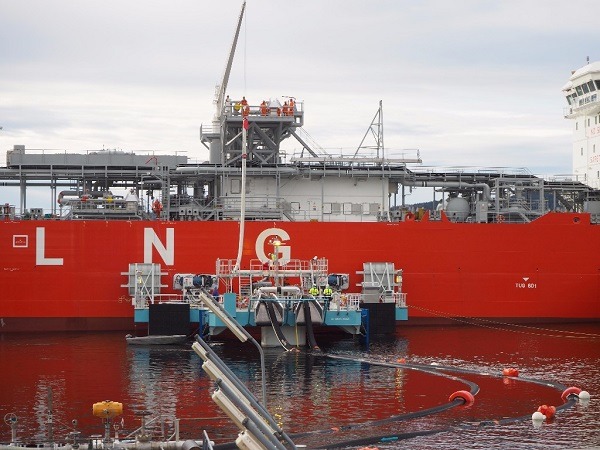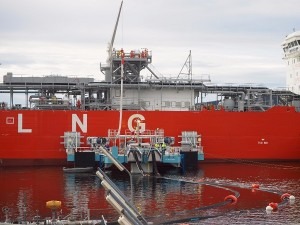Trelleborg on board world-first floating LNG system
The universal transfer system (UTS) was tested out on 7 October 2017: transferring LNG from the Skangas-chartered LNG carrier Coral Energy to the onshore terminal at the Norwegian port of Herøya.
Now in full commercial operation, the ‘plug-and-play’ system requires no modifications to the LNG carrier. Instead, the platform is manoeuvred offshore to meet a vessel.
The design, therefore, removes the need for costly and environmentally-intensive dedicated small/medium-scale LNG vessel harbour and jetty structures, Trelleborg explained.
The UTS consists of Trelleborg’s Cryoline LNG hoses, attached to a floating platform, which incorporates Trelleborg’s ship-shore link technology and a selection of its marine fender systems.
“The UTS shows that LNG infrastructure doesn’t need to be bound by the same thinking that underpins transfer solutions for fossil-based energy,” said Vincent Lagarrigue, director of Trelleborg’s oil and marine operation.
“Instead, it demonstrates how new ideas are creating the foundations for safe, efficient and convenient infrastructure that can keep pace with the rapid evolution of the LNG market, both as a power source and marine fuel,” he said.
Trelleborg’s expertise in fluid handling and LNG transfer has been essential to the project, Magnus Eikens, chief commercial officer of Connect LNG stated in the Swedish rubber company’s release.
“The Cryoline LNG hose is an integral part of this solution, thanks to its durability, flexibility, and safety features,” said Eikens. “What’s more, its ship-shore link technology and marine fender expertise is vital in supporting UTS LNG transfer operations.”
The UTS increases the operability of an LNG terminal, as the hose and platform can be retracted when not needed, or when harsh weather conditions would present hazards.
The platform-based solution can either function as a standalone unit, or enhance a larger terminal’s ability to handle deliveries to and from a broader range of vessels.
A range of Trelleborg technologies were employed in the new LNG transfer system. These include the Cryoline, said to be the first floating hose of its kind to receive EN1474-2 accreditation. It uses flexible rubber-bonded hose technology to minimise boil-off and withstand fatigue harsh environmental conditions.
Trelleborg also supplied its industry-leading USL 8810 to monitor the LNG transfer process. A triple fibre optic, five pin SIGTTO and pneumatic system was supplied to ensure all round flexibility for the platform for any visiting vessel.
A triple fibre optic, five-pin SIGTTO and pneumatic system was supplied to ensure all round flexibility for the platform for any visiting vessel.
Trelleborg’s Sea Guard fenders were specified for use at the front of the UTS to absorb berthing impact against the larger LNG vessel prior to attachment to the vessel.
And, to reduce the impact of the tug vessels on the UTS, Trelleborg’s Super Cone (SCN) fenders were specified to enable the tugs to safely push the UTS from shore into position for transfer operations.
This article is only available to subscribers - subscribe today
Subscribe for unlimited access. A subscription to European Rubber Journal includes:
- Every issue of European Rubber Journal (6 issues) including Special Reports & Maps.
- Unlimited access to ERJ articles online
- Daily email newsletter – the latest news direct to your inbox
- Access to the ERJ online archive






